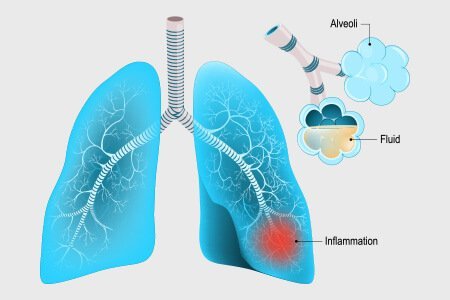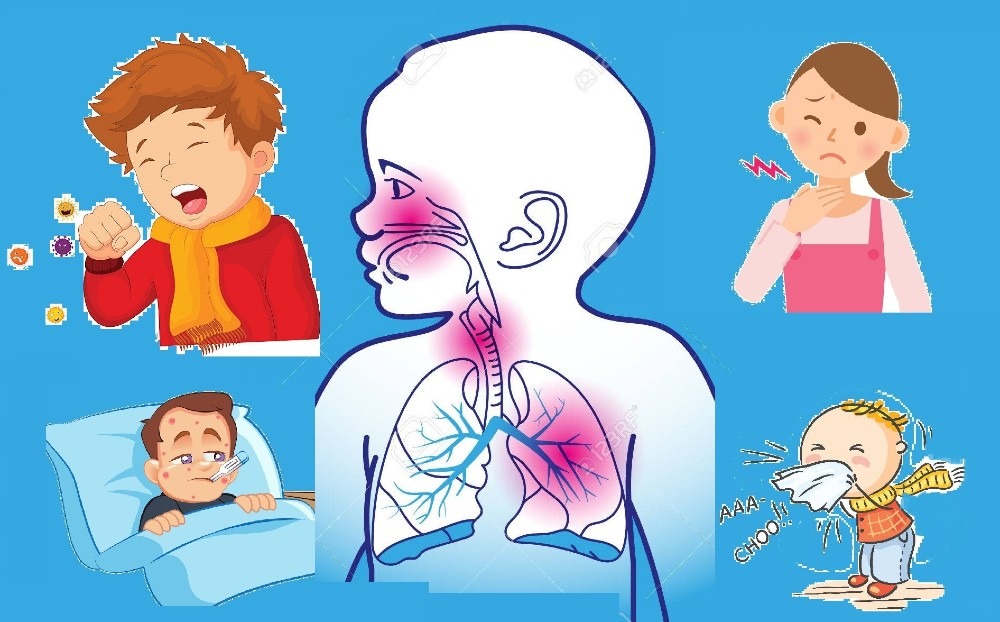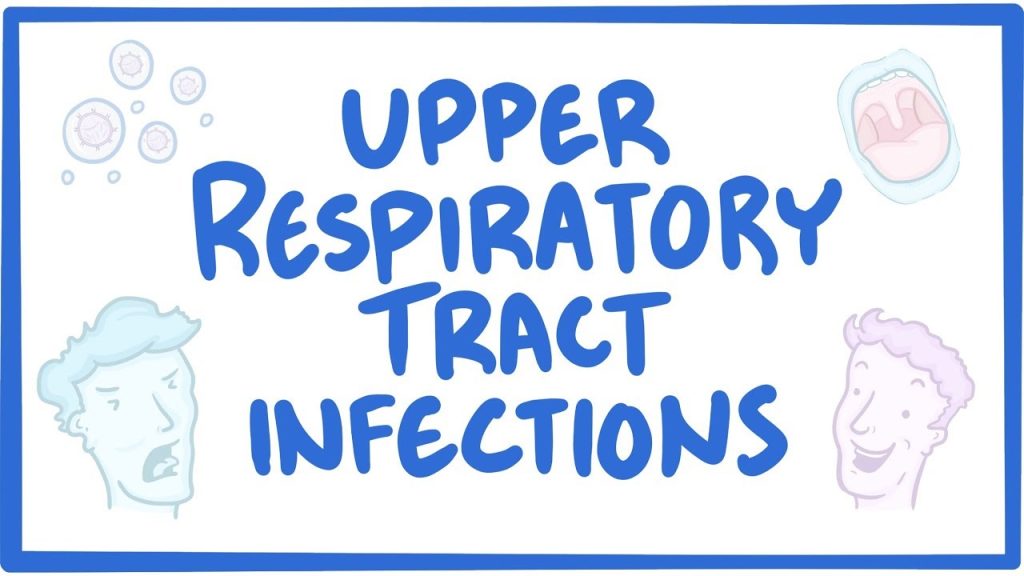Upper Respiratory Infection
Infections are everywhere, and humans are vulnerable to developing hundreds of infections every second. Upper respiratory infection is one of the prime examples of common infections.
The United States records 2.8 million cases of upper respiratory infection every year. The exact number of upper respiratory infections in the world is unknown, but the continent of North America records more than 4.6 million cases every year.
Public healthcare departments around the world, including the Centers for Disease Control and Prevention, suggest Americans learn about the basics of these upper respiratory infections.
The basics of these diseases can help you prevent them in the first place or seek immediate medical assistance. Keeping that in mind, we are here to help you understand upper respiratory infections and how you can ensure your safety against them.
Table of Contents
What is Upper Respiratory Infection?
Upper respiratory infections are a group of infections that affect the upper respiratory tract of humans. The upper respiratory tract of humans has four different parts, which include the nose, throat, sinuses, and Larynx.
Most upper respiratory infections are caused by viruses, but some bacteria may also cause similar symptoms. The common cold is one of the most common types of upper respiratory infections in the United States.
The symptoms of upper respiratory infections can include sore throat, fever, cough, and stuffy nose. Sinusitis, bronchitis, and sore throat are other common types of upper respiratory infections.
Most people don’t even require any medicine or medical assistance to recover from an upper respiratory infection. Patients can easily manage upper respiratory infections with supportive care.
Different home remedies are also very helpful in the treatment of upper respiratory infections. Your healthcare expert might suggest you take some rest and consume over-the-counter medication for different symptoms.
There are some ways you can opt to prevent upper respiratory infections. We highly recommend everyone take a deep look at the below-given sections for the same.
Also Read: What is Urinary Tract Infection?
Severe Upper Respiratory Infection
There is a small probability of severe upper respiratory infections. If you are struggling with any of the below-given symptoms of the condition, we highly recommend you consult with your healthcare provider.
Different types of viral and bacterial pathogens may lead a patient to severe complications, which include respiratory failure, pneumonia, and death.
Patients with serious upper respiratory infections require immediate medical assistance. You can’t treat these types of infections using home remedies. Home remedies might be a part of the whole treatment, but they cannot completely Treat it like a simple infection.
Also Read: What is the Cause of Urinary Tract Infection?
What are the Causes of Upper Respiratory Infection?
As we have already discussed, most upper respiratory infections are caused by viral infections, but bacteria may also cause the same.
We have discussed some of the most common types of bacteria and viruses which may result in Upper respiratory infection.
Common Viruses Causing Upper Respiratory Infections
Viruses are always going to be one of the biggest causes of upper respiratory infections. Different studies around the world have been integrating that around 90% of cases of upper respiratory infections are from viruses.
Viruses enter through our nose, and they attach themselves to the surface of the cell somewhere in the respiratory tract. Later, the virus will start multiplying itself and cause damage to the upper respiratory tract.
The whole multiplying will trigger the immune system in response to the virus, which may lead a patient to different symptoms, including a running nose, sore throat, stuffy nose, cough, and fever.
Here are some of the prime examples of upper respiratory infections causing viruses.
- Rhinoviruses – It is a highly common virus that is known to be responsible for the common cold.
- Influenza virus – it is another common virus of winter that is known to cause common flu.
- Respiratory syncytial virus (RSV) – is a highly common virus in infants and young kids.
- Coronavirus – responsible for the common cold and some severe respiratory illnesses, including COVID-19.
- Adenovirus – It may also cause a range of respiratory illnesses, including bronchitis, pneumonia, and conjunctivitis.

Upper Respiratory Infection-Causing Bacteria
Bacteria might be responsible for just 10% of upper respiratory infections around the world, but we cannot completely rule out its probability.
There are several upper respiratory infections causing bacteria, and it’s important to learn about those as well.
There is no difference between the symptoms of bacterial upper respiratory infection over viral upper respiratory infection.
Most of its symptoms are going to be the same as viral upper respiratory infection. Here is the list of common bacteria causing upper respiratory infections.
- Streptococcus pneumonia – It is a highly common cause of bacterial pneumonia.
- Haemophilus influenza – This type of bacteria might cause pneumonia and other respiratory infections.
- Bordetella pertussis – It is known to cause whooping cough.
- Mycoplasma pneumonia – This type of bacteria might cause a mild form of pneumonia, also known as walking pneumonia.
- Group A Streptococcus – It is known to cause strep throat, tonsillitis, and other respiratory infections.
You should take a deep look at both of the most common upper respiratory infections causing viruses and bacteria. The basic knowledge of both of them can help you prevent the condition in the first place.
Also Read: What are the Urinary Tract Infections Home Remedies?
What are the Symptoms of Upper Respiratory Infections?
Along with its major causes, the Centers for Disease Control and Prevention recommend Americans learn about the major symptoms of upper respiratory infections.
It is highly important to understand all the aspects of the condition to prevent it in the first place or get early treatment.
Upper respiratory infections may have a bigger number of common symptoms than the below given. As you are already aware, the upper respiratory system of humans includes four parts, and infection of those body parts can have different symptoms.
Here are some of the most common symptoms of upper respiratory infection.
- cough
- discomfort in the nasal passages
- a mild fever
- excess mucus
- nasal congestion
- pain or pressure within the face
- a runny nose
- a scratchy or sore throat
- sneezing
These are some of the most common symptoms of upper respiratory infection. Apart from that, healthcare experts around the world also believe that symptoms like headache, Itchy eyes, body aches, and bad breath are also part of upper respiratory infections.
Also Read: What is the Best Antibiotic for Urinary Tract Infection?
Common Types of Upper Respiratory Infections
As you are already aware, there are tons of different types of upper respiratory infections. Healthcare experts around the world have categorized them according to the part of the respiratory tract.
Before we move ahead, let’s take a quick look at some of the most common types of upper respiratory infections and their symptoms.
- The common cold is one of the most common types of upper respiratory infections. Several viruses in the world can cause common colds, and the symptoms may include sore throat, headache, muscle ache, sneezing, coughing, fever, and pressure over the years.
- Sinus infection is another common type of upper respiratory infection. It’s a highly common infection that can include a large number of symptoms like nasal discharge, blocked Nose, fever, bad breath, pain around the eyes, cheeks, or forehead, and sinus pressure.
- Laryngitis is the inflammation of vocal cords, which is Highly common in the North American Continent. This type of infection includes symptoms like sore throat, Hoarse voice, loss of voice, and persistent cough.
If you are struggling with any of the above-given conditions, there is a high probability you are struggling with upper respiratory infections.
Most people don’t even require any medicine or medical assistance to recover from upper respiratory infections, but we highly recommend you consult with your healthcare provider and ensure your safety under any circumstances.
Also Read: What are the Symptoms of a Urinary Tract Infection?
How do I know if My Upper Respiratory Infection is Viral or Bacterial?
As you are already aware, around 90% of cases of upper respiratory infections around the world are caused by viral infections. Mere 10% of cases of upper respiratory infection in the whole world are from bacteria.
You are going to think about questions like how you know if you have an upper respiratory infection from viral infection or bacteria.
To be honest, it is very difficult to diagnose what is causing upper respiratory infection. Whether it’s a viral infection or a bacterial infection, it’s always a wise decision to consult with your healthcare provider.
Most symptoms of bacterial and viral infection overlap when it comes to upper respiratory infection. We do not recommend anyone to self-diagnose themselves for any upper respiratory infection.
You can follow some of the below-given guidelines to take precautions, but you should never self-diagnose based on that.
Development of Symptoms
- There is a huge difference between the development and the peak of symptoms from bacterial and viral infections.
- Symptoms of bacterial infection appear more suddenly, and they persist for a longer period as compared to viral infections.
- The symptoms of viral infection take a little bit longer to develop, and they usually peak within a week or so.
Symptoms
- Most symptoms of bacterial and viral infection overlap, and it’s highly unlikely that a person will self-diagnose himself correctly simply based on the symptoms.
- Still, Some symptoms like fever are more common with bacterial infection while they are not common in viral infection.
- Apart from that, the degree of temperature may also be a sign of bacterial or viral infection.
- Healthcare experts around the world believe that a body temperature of 100.4 degrees Fahrenheit indicates that it could be a bacterial infection.
Apart from fever, healthcare experts also believe that bacterial infection can cause symptoms that are not typically seen in viral infections.
For example, a bacterial sinus infection may cause a long list of symptoms, including thick and yellow mucus, persistent pressure on the face and ears, and reduced smell or taste might indicate more clearly.
If you want to self-diagnose simply based on the symptoms, you need to learn about the basics of different common viral and bacterial infections. The combination of all these things will help you in self-diagnosis.
Medical History
The previous medical history of the patient may also indicate the difference between viral and bacterial infection.
Healthcare Experts around the world are building that people with a previous medical history of frequent viral or bacterial infections are going to have it once again.
If you are among those people who get viral or bacterial infections again and again, you might be struggling with the same this time as well.
Different risk factors may also help the patient in the self-diagnosis. For example, the sudden rise in viral infections in your society or workplace is a clear indication that you are struggling with the same.
It’s highly unlikely that the whole community is struggling with viral infections, and you are struggling with some bacterial infection.
Professional Diagnostics
Despite all your efforts and knowledge, you might misdiagnose yourself for the cause of upper respiratory infections.
We highly recommend everyone consult with their healthcare provider as several medical tests can help you in the diagnosis.
Healthcare experts usually recommend throat culture over blood tests to diagnose the cause of upper respiratory infections. These tests are not expensive, and you can get yourself tested from any nearby pharmacy.
How Long Does an Upper Respiratory Infection Last?
And there are tons of different causes of upper respiratory infections, and their duration also depends on those infections.
There is no fixed duration of upper respiratory infections, and healthcare experts cannot fix any number when it comes to questions like how long does an upper respiratory infection last.
Usually, common viral infections tend to stay in the system for around 7 to 10 days. Apart from that, some of its symptoms might also last up to 2 weeks.
People easily recover from viral infections, and they don’t even require any medicine or medical assistance.
At the same time, bacterial upper respiratory infections might impact the patient for a longer period. If bacterial infections are left untreated, they might stay in the system for a longer period.
Bacterial infections also require antibiotics to resolve as they don’t go on their own without any major complications.
Factors Influencing the Timeline of Infection
Several factors impact the overall period of upper respiratory infections. Healthcare experts recommend everyone consult these infections with their healthcare provider as they have the capabilities to cause life-threatening conditions.
- People who smoke cigarettes might have to struggle longer when it comes to upper respiratory infections. Irritants like tobacco are known to weaken the immune system and cause different respiratory complications.
- Different studies also believe that smokers struggle with respiratory infections more frequently than nonsmokers. At the same time, they also have to seek medical assistance to recover most of the time.
- People with poor nutrition and diet have to struggle for a longer period than a person who is focusing on a regular diet.
- Our diet also influences the immune system, which helps our body with five different diseases. Healthcare experts also recommend everyone focus on diet as soon as they develop an upper respiratory infection.
- Different medical conditions, including stress and depression, might also interfere with the timeline of upper respiratory infection.
- People who are struggling with any mental condition should consult with their healthcare provider despite its severity.
- The age of the patient also claims a major part in the duration of the timeline of symptoms. For example, healthy adults between the age of 18 to 55 recover at a much faster pace as compared to infants, young children, or older adults.
- The previous history of different infections might also influence the timeline of symptoms. People who already have a history might have to struggle for a longer period than a person who is getting an upper respiratory infection for the very first time.
Apart from the above-given factors, healthcare experts also believe that people who focus on recovery are always going to recover at a much faster pace than a person who is not focusing.
For example, healthcare experts recommend adequate rest, a good diet, and hydration to recover from an upper respiratory infection. People who do not focus on recovery might have to spend a longer period in recovery.
If you have developed any symptoms associated with the condition, you should consult with your healthcare provider. If the upper respiratory infection is from a bacterial infection, you will have to consume antibiotics as it helps you shorten the duration of symptoms.
The bacterial infection stays in the system for a longer period as compared to viral infection.
Is an Upper Respiratory Infection Contagious?
Yes, upper respiratory infections are contagious. As you might already be aware, most causes of upper respiratory infections are caused by viruses or bacteria.
These common viruses and bacteria are known to be contagious, and they can spread from one person to another through different channels.
Healthcare experts around the world recommend everyone stay away from people who are struggling with an upper respiratory infection, or you can also follow complete COVID protocol to prevent the infection in the first place.
The Centers for Disease Control and Prevention of the United States released a set of guidelines at the start of the COVID infection so that Americans and people around the world can easily prevent the infection of the virus in the first place.
Those guidelines, which include regular use of face masks, social distancing, and use of hand sanitizer, can also help you prevent upper respiratory infections in the first place.
You can use a face mask and social distance whenever you are meeting someone who is struggling with upper respiratory infections.
Upper respiratory infections are spread through different channels, including respiratory droplets from Cough, sneezing, breathing, and talking.

Prevention from infection
Before we move ahead, let’s take a quick look at some of the most important tips that can help you prevent upper respiratory infections even while living with your family.
You should make sure you are following the complete COVID protocol during the first few days of the illness, as upper respiratory infections are the most powerful during the first half of the illness.
If you have started to develop any symptoms associated with upper respiratory infections, you should make sure you are a social distance and use a face mask to prevent the infection in your family.
Once the symptoms have made their peak, there will be less probability that you will spread the infection to others.
Everyone in your family can also follow high levels of hygiene to prevent upper respiratory infections. It’s highly important to practice good personal hygiene, including regular use of hand wash, covering your mouth and nose while coughing, and avoiding contact with others who are sick or vulnerable to developing severe sickness.
Also Read: How Does a Woman Get a Urinary Tract Infection?
How to Diagnose Upper Respiratory Infections?
Despite all the clear evidence, you should never self-diagnose yourself for upper respiratory infection.
You might not get surprised to know that most symptoms of upper respiratory infections are also associated with several other diseases.
Many serious and life-threatening diseases may have similar symptoms as upper respiratory infections. We highly recommend everyone consult with their healthcare provider.
Basic Test
When you visit your healthcare provider for the diagnosis of upper respiratory infection, your healthcare expert will start with the basic test, which includes talking about the disease and symptoms.
Your healthcare expert will try to gather as much information about your disease as possible. The questions can include the length of symptoms, the severity of symptoms, and your previous history with similar diseases.
Apart from the questions, your healthcare experts will also try to take a look at your nose, throat, and mouth to find any signs of damage.
Basic testing or basic physical test is more than enough for healthcare experts to diagnose upper respiratory infection.
If your doctor believes you are not struggling with any serious infection, or you are in healthy condition, and the symptoms will go away from me, you might not require any other additional test for the diagnosis.
Additional Tests
Additional tests for the diagnosis of upper respiratory infection are not recommended for every person. Healthcare experts only recommend additional or advanced tests to patients where they believe the patient might be struggling with some serious infection.
Apart from that, people who are already struggling with other chronic medical conditions or those who have been declared immune compromised might have to go through advanced tests.
Healthcare experts will recommend additional tests to patients where they want to rule out other probabilities.
- Advanced screening, which includes X-ray and CT scans, is recommended under certain conditions. Both screening tests can help your healthcare expert rule out other conditions, including pneumonia, and find the severity of the infection.
- Your healthcare expert may also recommend you to go for a blood test as it can help them check for any signs of infection and inflammation in the body.
- A nasal swab and a throat swab test for the diagnosis of upper respiratory infection is another common laboratory-based test.
- During the test, a healthcare expert will take a sample of mucus or tissue from the nose or throat to determine the type of virus or bacteria causing the infection.
We highly recommend everyone opt for a nasal swab or throat swab test to diagnose the exact type of virus or bacteria causing the infection.
Once your healthcare experts have found the right cause of the infection, they can move ahead and start the treatment.
It is important to find the right bacteria or virus causing the infection as it can help healthcare experts in the treatment.
What is the Treatment for Upper Respiratory Infections?
Once your healthcare experts have successfully directed most of the causes of the condition, it is time for you to focus on its treatment.
Before we start, let me remind you that the treatment of upper respiratory infection is also going to focus on the combination of self-care measures and modern medicine.
Healthcare experts can help you lower the impact of different symptoms using modern medicine, but you will have to focus on self-care measures and home remedies to completely flush the infection out of your system.
Home Remedies
There is a long list of things you can do as self-care or home remedies for the treatment of upper respiratory infections.
Kindly remember, do not make the mistake of following just one home remedy or treatment option. A lot of people around the world follow just one home remedy. One home remedy is not going to help you with an upper respiratory infection or any other type of infection.
- Salt water gargling is probably one of the most common home remedies for the treatment of upper respiratory infections. It can help you with symptoms like inflammation and sore throat.
- Steam inhalation is another popular home remedy for the treatment of upper respiratory infections. It can also help you with symptoms like congestion and cough.
- You can also use organic or all-natural honey in tea or warm water. It can also help your sore throat and cough.
- Chicken soup does not require any introduction. You can use chicken soup as a home remedy for upper respiratory infections as it can help you with different Symptoms, including sore throat and cough.
- Staying hydrated is another common and highly effective home remedy for different infections, including upper respiratory infections. You can consume fluids like water, tea, and clear broth.
Apart from the above-given list of common home remedies for the treatment of upper respiratory infections, you can also focus on rest.
Rest will allow your body to heal quickly as your immune system won’t have any other job.
You should make sure you are focusing on as many home remedies as possible. These home remedies are going to take a little bit longer time as compared to modern medicine to treat upper respiratory infections.
Kindly do not leave these home remedies until you are feeling perfectly fine.
Modern Medicine
As we have already discussed, Health care experts around the world recommend a combination of home remedies and modern medicine to treat upper respiratory infections.
Till now, we have only discussed the first part of the treatment of upper respiratory infections. Now we are going to discuss the second part, which will contain modern medicine.
We have divided the modern medicine treatment option into two different sections containing information for over-the-counter medicine and prescription medicine for the treatment of upper respiratory infections.
Over the Counter
- Decongestants are the most popular over-the-counter treatment option for upper respiratory infections. You don’t require any prescription to purchase these decongestants, And they can help you with symptoms like nasal congestion.
- Nasal sprays are a popular over-the-counter treatment option for upper respiratory infections. Similar to decongestants, nasal sprays can also help you clear the nasal passage and improve your breathing.
- Medicine like ibuprofen can also help you with different symptoms, including fever and body aches.
- Cough suppressants are another popular over-the-counter treatment for upper respiratory infections. Patients with Cough as a prime symptom of the condition can take cough suppressants.
These are some of the most common over-the-counter modern medicine for upper respiratory infections. You don’t require any prescription to purchase them, but we highly recommend you consult with your healthcare provider.
Despite being over-the-counter medicine, these medicines can interact with other medicines and medical conditions. Make sure you are taking full precautions before consuming any medicine whatsoever.
Prescription Medicine
There is a long list of prescription medicines for upper respiratory infections. As there are different types of upper respiratory infections, healthcare experts have tons of different options.
Healthcare experts consider a huge number of things before suggesting any medicine to treat an upper respiratory infection or any other condition.
- Antibiotics and antivirals are the most commonly prescribed medicine to treat upper respiratory infections. Depending on the diagnosis, healthcare experts recommend either antiviral or antibiotics to treat upper respiratory infections.
- Under certain conditions, your healthcare expert might also recommend you to take steroids as they can help you In the reduction of inflammation and swelling.
- Steroids are highly common when Upper respiratory infection starts causing symptoms like wheezing and shortness of breath.
We do not recommend anyone change the dosage or the medicine to treat an upper respiratory infection without consulting with their healthcare provider.
We have just provided the options, which you can consult with your healthcare provider. We do not advise anyone to change their medicine simply based on the above-given options.
What is the Fastest Way to Get Rid of an Upper Respiratory Infection?
Upper respiratory infections take around seven days to get better. There is no fastest or quickest way to cure upper respiratory infections.
Healthcare experts around the world recommend everyone focus on it combining modern medicine with home remedies to completely cure upper respiratory infections as early as possible.
Several things may influence the whole recovery period of upper respiratory infection. Take a look at the below-given points and try to understand the recovery period of upper respiratory infections.
Combined Home Remedies and Medicine
As we have already discussed, combining home remedies with medicine can help you recover at a much faster pace than you can ever imagine.
A lot of patients with upper respiratory infections do not focus on home remedies when it comes to treatment after the condition.
Modern medicine for upper respiratory infections is highly effective, but it can not help you get rid of the infection completely and quickly.
You will always have to combine both things to get better as early as possible.
Factors Influencing the Recovery Time of Upper Respiratory Infection
There is a long list of things you have to do, which also includes avoiding irritants. As you are already aware, the upper respiratory infection causing bacteria or virus might take around 7 to 14 days to completely get out of the system.
Several factors may affect the recovery time of upper respiratory infection, And those factors might include:

Diagnosis
The diagnosis of upper respiratory infection is one of the biggest factors which can influence the whole recovery period.
As you are already aware, different types of viruses and bacteria might cause upper respiratory infections. You need to opt for a professional diagnosis.
There is less probability that you can diagnose yourself without a laboratory test to determine which virus or bacteria is causing the infection.
We highly recommend you visit a healthcare provider and find the infection-causing bacteria or virus to start the treatment.
Treatment
The start of treatment is also going to play an equal role in the recovery of upper respiratory infection as Diagnosis and other factors.
The diagnosis of upper respiratory infection is just one part, but you also have to focus on that treatment as well.
Everyone should get immediate treatment for upper respiratory infection as soon as the diagnosis is confirmed, as per the Centers for Disease Control and Prevention of the United States.
Healthcare experts around the country also recommend everyone start that treatment as it can help you in the early recovery, which will significantly lower the whole infection timeline.
Medical history
The medical history of the patient is another popular and highly influencing factor that may increase or decrease the full recovery period of upper respiratory infection.
People who already have a medical history of serious diseases might take a bit longer time to recover from an upper respiratory infection.
People who have already been declared immune compromised might also have to struggle for a longer period to get completely rid of upper respiratory infections, as per the Centers for Disease Control and Prevention of the United States.
If you are among those people who have been declared immune compromised or have a medical history of serious disease, I highly recommend you always discuss the diagnosis and treatment of upper respiratory infection with your healthcare provider.
Underlying Medical Conditions
Underlying medical conditions, which may include diabetes, asthma, and infections like HIV, may also increase the whole recovery time of upper respiratory infection.
As we have already discussed in the above-given section, people who already have a medical history or underlying medical condition should consult the diagnosis and treatment of upper respiratory infections with their healthcare provider.
Other Factors
Apart from the above-given factors, several other factors may also influence the whole recovery period of upper respiratory infections.
- First of all, the age of the patient may also play a major role in the recovery and timeline of the recovery period. For example, infants and young children take longer time to recover than healthy adults.
- The selection of the treatment process may also play a major role. We highly recommend everyone consult with an experienced healthcare professional.
- Different lifestyle factors, including a healthy diet and sleep. Avoiding smoking may also help you in a faster recovery.
Take a deep look at all of the above-given points for faster recovery from upper respiratory infections. There is no magical remedy available in this world that can help you recover from upper respiratory infection as early as 24 hours.
How Long Does Azithromycin Take to Work for Upper Respiratory Infection?
Azithromycin is An important antibiotic to treat upper respiratory infections. Even though most cases of upper respiratory infection are from viruses, under certain conditions, bacteria may also impact and cause upper respiratory infection.
If the cause of your upper respiratory infection is bacteria, there are several things you should keep in mind, including the whole timeline of treatment.
Bacterial infection takes a little bit longer when it comes to recovery as compared to viral infections.
Azithromycin Is a versatile antibacterial that is also used for different conditions, including respiratory tract infections, sexually transmitted infections, and skin and tissue infections.
Generally, Azithromycin takes around one to 2 days to deliver any noticeable improvements in symptoms of upper respiratory infection.
Different factors may influence the whole working timeline of the medicine when it comes to upper respiratory infections.
Influencing Factors
Similar to any other medicine and treatment in the world, Azithromycin also has a long list of factors that may influence the timeline of improvement of symptoms.
- First of all, the sweet combination of the dosage of the medicine and the severity of the treatment is going to play a major role in the influencing factors.
- Healthcare experts recommend the dose of the medicine depends on several factors, including the age of the patient, common security of the symptoms, and previous History with similar medicine.
- The previous medical history of the patient may also play a major role, as people with a history of similar diseases require a higher dosage, and any negligence may result in a longer period of results.
These are some of the most common influencing factors which may influence the timeline of recovery and delivering any results.
Side Effects of Azithromycin
Before we move ahead, let’s take a quick look at some of the most common side effects of the medicine. Similar to any other medicine in the world, Azithromycin also has a long list of side effects.
You should be very well aware of these side effects before consuming. Most people don’t require any additional medicine to recover from due side effects, but you should not hide them from your healthcare provider.
The common side effects of Azithromycin may include the following:
- Difficulty while breathing
- Difficulty while swallowing
- Serious diarrhea
- Yellowing of eyes
- Unusual tiredness
- Weakness
- Irregular heartbeat
- Lightheadedness
- Swelling on the face, lips, and tongue
If you are struggling with any of the above-given symptoms, you should consult with your healthcare provider. You might not require any medicine at all, but your healthcare expert needs to know about them.
Apart from the above-given list of common side effects, there could be some serious side effects which may include severe allergic reactions, liver problems, and respiratory Complications.
What is the Strongest Antibiotic for Upper Respiratory Infection?
The use of antibiotics is highly common in the treatment of upper respiratory infections.
Healthcare experts recommend the use of antibiotics when they believe a laboratory test confirms that the upper respiratory infection is the result of some bacterial infection.
In most cases of upper respiratory infection, common healthcare experts recommend antiviral or antibiotic to get rid of the infection depending on the infection-causing microorganism.
The Need for the Strongest Antibiotics
The treatment of upper respiratory infections can take more than seven days, depending on the cause of the infection. For example, bacterial infections take a longer time to recover as compared to viral infections.
No wonder a lot of patients with upper respiratory infections have been looking for the strongest antibiotic to recover from the infection as early as possible.
Before we move ahead, let’s take a look at some of the most important uses of the strongest antibiotic in the world.
- First of all, healthcare experts recommend a strong antibiotic when the infection has reached a serious stage.
- If the normal antibiotics are not working, your healthcare expert might recommend you take strong antibiotics to recover from severe infections, including pneumonia and meningitis.
- Different types of bacteria require different types of antibiotics. Some bacteria are not going to go away with regular antibiotics. Those types of bacteria recover wire with strong antibiotics.
- Previous history of the patient with different types of antibiotics may also require a healthcare expert to suggest a strong antibiotic. We highly recommend everyone open their previous history of different diseases with their healthcare provider.
- Patients with underlying medical conditions or those who have been declared immune compromised might also require a strong antibiotic. It is not recommended for everyone, but in most cases, It is required.
Apart from the above-given conditions, your healthcare expert might also recommend you consume a stronger antibiotic if there is a risk of serious complications.
If you do not fall in any of the above-given categories, you should not consume or ask for the strongest antibiotic.
Despite having all the clear signs or information, you should never consume any antibiotics on your own. You should always consult with your healthcare provider and try to consume prescribed medicine only.
Strongest Antibiotics for Upper Respiratory Infection
There is a long list of antibiotics available in the market that can help you in the treatment of upper respiratory infections.
Most cases of upper respiratory infections are caused by viruses, and antibiotics are not going to work on them. Still, there are several antibiotics available in the market that can help you in the treatment depending on the bacteria.
- Amoxicillin is a commonly used antibiotic for the treatment of different bacterial infections, such as strep throat and acute sinusitis. It belongs to the class of antibiotics known as penicillins, which can also help in upper respiratory infections. Amoxicillin is Priced around $5 to $10 depending on the company for a 10-day Supply.
- Azithromycin is another common antibiotic that is effective against a wide range of Bacterial infections. It is often used to treat bacterial infections of the respiratory system, including pneumonia, bronchitis, and sinusitis. Azithromycin is priced around 20 to $50 for a five-day supply.
- Clarithromycin is also a strong antibiotic that is used to treat respiratory tract infections caused by bacteria such as Streptococcus pneumonia, Haemophilus influenza, and Moraxella catarrhalis. You can easily purchase a ten-day supply of Clarithromycin for around $30-$80.
- Doxycycline is another inclusion in the list of strong antibiotics that are effective against a wide range of bacteria. It is often used to treat respiratory tract infections such as sinusitis, pneumonia, and bronchitis.
Antibiotics are not available as over-the-counter medications, and it is highly regulated by the Food and Drug Administration of the United States.
Even if you get your hands on strong antibiotics, you should not consume the medicine without consulting it with your healthcare provider.
What is the Right Dosage of Prednisone for Upper Respiratory Infection?
Along with antibiotics and antiviral, healthcare experts also recommend steroids like Prednisone, where the upper respiratory infection is getting out of hand and causing serious complications.
Prednisone is not the first line of treatment for any upper respiratory infection. Healthcare experts do not recommend steroids like Prednisone as the first line of treatment when it comes to upper respiratory infection.
The general dose of Prednisone for upper respiratory infection is going to be between 10 milligrams to 40 milligrams a day.
The treatment of upper respiratory infection is going to start with a regular antibiotic or antiviral. If the symptoms are not getting away and the situation is getting worse, your healthcare expert might recommend you take steroids like Prednisone.
Dosage of Prednisone for URI
The dosage of any disease is going to depend on different factors. Despite getting your hands on a stronger dose of Prednisone or any other medicine, you should never consume it without consulting with your healthcare provider.
Different factors may influence the whole dosage of Prednisone for upper respiratory infection. Everyone needs to consult the right people with their healthcare provider.
Everyone has different needs depending on different factors, and healthcare experts do not recommend anyone overdose. There could be some serious complications or side effects which we have discussed in the below-given section.
Dosage Influencing Factors
- The Seriousness of the symptoms is always going to be one of the biggest factors when it comes to the dosage of any medicine, including Prednisone for upper respiratory infection.
- People with severe infection Require a higher dosage of Prednisone or any other similar medicine.
- Other underlying conditions, including chronic diseases, may also impact the dosage of Prednisone for upper respiratory infections.
- People with serious complications, including pneumonia, require a higher dosage of Prednisone than a regular person.
- The age of the patient might also play a major role in the dosage of medicine for upper respiratory infections. Young children and old age patients usually require lower doses than adults.
- The previous history of the patient with a similar medicine might also play a higher role in the dosage. For example, people who already have a history of consuming similar medicine might require a bigger dosage.
Your healthcare expert is going to suggest that dosage depends on different factors and your risk-to-reward ratio.
Your healthcare expert is going to figure out all these things and try to find the right dosage where you will get more benefits than side effects of Prednisone for upper respiratory infections.
Side Effects of Prednisone
There could be hundreds of different side effects of an overdose of Prednisone. If you have overdosed on Prednisone, we highly recommend you consult your healthcare provider right away.
Overdose of Prednisone is never going to be in your favor, and the medicine is known to cause some serious side effects.
- Increased appetite and weight gain
- Mood changes, such as irritability or agitation
- Difficulty sleeping or insomnia
- Increased blood sugar levels, which can lead to diabetes
- Fluid retention and swelling in the legs and ankles
- Increased risk of infections
- Increased blood pressure
- Weakened bones or osteoporosis
- Thinning of the skin and easy bruising
- Cataracts or glaucoma
- Muscle weakness or wasting
These are some of the most common side effects of Prednisone. Apart from the above-given list, there could be several other serious side effects of the medicine, which may include infections, bone loss, glaucoma, and cataracts.
We do not recommend anyone increase or decrease the dose of medicine without consulting with their healthcare provider. If your healthcare provider has not suggested your medicine for the treatment of upper respiratory infections, you should never conserve it under any circumstances.
Which is the Best Over-The-Counter Medicine for Upper Respiratory Infection?
The treatment of upper respiratory infection can be complicated if you are not consulting with any healthcare provider.
There are a huge number of bacteria and viruses that may result in upper respiratory infections. You need to consult the diagnosis with your healthcare provider to determine the right cause and start the treatment according to that.
Different types of viruses and bacteria require different types of medicine. We also understand that sometimes it’s not possible to visit any healthcare providers and consume over-the-counter medicine to get some relief.
Keeping that in mind, we are here to help you understand some of the most important over-the-counter medicine for upper respiratory infections.
Over-the-Counter Medicine for Uri
- Pain relievers are one of the most effective over-the-counter medicines for upper respiratory infections. Healthcare experts recommend Tylenol or ibuprofen for different symptoms of upper respiratory infections, including headache, fever, and body aches.
- You can also use decongestants to get relief from different symptoms, including nasal congestion. Healthcare experts usually recommend Sudafed, which is a highly popular decongestant.
- You may also take a cough suppressant if you are struggling with symptoms like a cough.
There are not many options available as an over-the-counter medicine for the treatment of upper respiratory infections.
Most people with upper respiratory infections require antiviral or antibacterial, depending on the cause of the infection. Both of these medicines are available as over-the-counter medications, and You cannot purchase them without a prescription.
Also Read:
Urinary Tract Infection Urinating after Sexual Intercourse
Home Remedies for Upper Respiratory Infection
As we have already discussed multiple times, you need to combine your modern medicine or over-the-counter treatment with home remedies to get rid of upper respiratory infections completely.
Apart from that, there are not many treatment options available for upper respiratory infections as an over-the-counter medicine. You will have to focus on home remedies for the treatment without consuming any modern medicine after getting a prescription.
Some of the common home remedies for upper respiratory infection may include:
- Stay hydrated
- Rest
- Use a humidifier
- Gargle with salt water
- Drink warm liquids
- Use a saline nasal spray
- Take a hot shower or bath
- Use a warm compress on your sinuses
- Drink ginger tea
- Use essential oils
These are some of the most common home remedies for upper respiratory infections. We highly recommend everyone follow all the above-given home remedies as the combination of modern medicine along with these home remedies can help you get better within a few days.
You might be able to get a little better from just one home remedy, but that is not going to work on all the symptoms of the condition. You can also deep dive into the above-given sections and find the use of different home remedies according to the symptoms you are struggling with.
How Much Penicillin to Give a Kitten for an Upper Respiratory Infection?
As a cat owner, you might or might not get surprised to know that your kitten may Also get respiratory infections similar to you. Upper respiratory infection is also a common type of respiratory infection in kittens.
These types of upper respiratory infections are cold Feline viral Rhinotracheitis or Feline Herpesvirus-1.
Causes of Upper Respiratory Infections in Kitten
There could be several causes when it comes to upper respiratory infections in kittens. First of all, the sudden rise in viral infections might also result in upper respiratory infections in Kittens.
Apart from that, a stressful environment, including an animal shelter, may also result in different infections, including upper respiratory infections. You need to keep your vulnerable kitten away from crowded or stressful situations.
Symptoms of Upper Respiratory Infection in a Kitten
Before we move ahead, Let’s take a quick look at some of the most important symptoms of upper respiratory infection in kittens.
There could be a long list of symptoms of upper respiratory infection in a kitten, but we have listed some of the most common in the below-given section
- Dehydration
- Loss of appetite
- Coughing
- Fever
- Watery eyes
- Running nose
- Sneezing
- Conjunctivitis
- Ulcers
If your kitten has any of the upper given symptoms, you need to take your return to a veterinarian. Professional diagnosis is highly important for the treatment of upper respiratory infections.
Dosage of Penicillin for Kitten
Penicillin is an important antibiotic used to treat upper respiratory infections in kittens. It is a prescription drug that is only available with a prescription from a licensed physician.
Since it is also used in several other infections, you might be wondering what the right dose of penicillin for kittens to treat upper respiratory infections is.
As we are already aware, it is a prescription drug, so you should not give it to your kitten without consulting with your healthcare provider.
There could be hundreds of different side effects of using the medicine, and we highly recommend everyone consult with their healthcare provider.
There are tons of different factors which may influence the dosage of penicillin, Including:
- Age of the kitten
- Previous medical history of the kitten
- Overall weight
- The overall health of the kitten
- The severity of the symptoms
- Other underlying medical conditions
These are some of the most common factors that you are going to keep in mind before suggesting the dosage of penicillin to your kitten.
About given factors, physicians may also keep in mind the different forms of medicine. As penicillin is also available in tablets, capsules, and injectable solutions, you need to discuss its right dosage with your healthcare provider.
Which is the best medicine for the treatment of upper respiratory infection?
There is no best medicine for the treatment of upper respiratory infections. Healthcare experts recommend a combination of modern medicine along with home remedies to get rid of upper respiratory infections.
How to diagnose upper respiratory infection?
You should always visit a healthcare professional for the diagnosis of conditions like an upper respiratory infection. There are different causes, including viruses and bacteria, which may result in upper respiratory infections. A professional diagnosis will help you start the right treatment.










